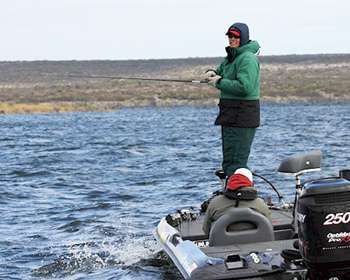
When fishing a lipless crankbait such as a Rat-L-Trap or Red Eye Shad, anglers often fail to put much thought into varied retrieves. Even fewer think of lipless crankbaits as being effective when presented vertically over grass.
Elite Series pro James Niggemeyer believes that failing to recognize the bait's vertical prowess will oftentimes lead to missing out on the best bites. "A lot of my lipless crankbait presentations are done on a straight retrieve. But yo-yoing or pumping a Strike King Red Eye Shad can be a phenomenal way to catch bass," says the Texas pro.
Niggemeyer often varies his presentation, depending on the type of structure he's targeting. "If I'm fishing over a drain, for example, I might start out by burning the Red Eye Shad on a straight retrieve," he says. "On the next cast, I will alternate from burning it to pumping it and letting it flutter vertically. It's really going to be dictated by the mood of the fish."
The 2010 Bassmaster Classic qualifier points out that when bass are following the bait on a straight-line retrieve but not committing, simply stopping the retrieve and "pumping" the rod tip will elicit a reaction strike. "When you're yo-yoing a lipless bait, it emits a completely different sound than one reeled steadily back," he says. "Also, the way the bait shimmies as it falls will oftentimes get a reaction when nothing else will. You can have a bass that will follow the bait for a long distance but never commit. As soon as you start to pump or yo-yo the bait, the fish will be all over it," Niggemeyer explains.
Niggemeyer says that he encounters many anglers who are surprised to learn of a lipless bait's prowess when fished vertically. "It's a bottom-weighted bait, so as it falls it really mimics a baitfish that's struggling," he points out.
"That is so critical because it looks like an easy meal. I feel that the fish see a lipless bait being yo-yoed and they think that they're not going to have to work too hard to eat, so they come up behind it and scoop it up."
Niggemeyer says that when yo-yoing a lipless crankbait, the bite on the fall resembles a worm bite, or one that anglers might anticipate when fishing a jig. "Usually it's just a definite 'tick' as the bait is falling," he explains.
"Also, when you're yo-yoing a lipless bait you tend to get a better hook-up because the bass can swallow the bait. This is much different that the hook-up percentages that you'll see when burning the same bait, where you'll get a lot of bass that are hooked on the outside of the mouth."
He explains that the best time for yo-yoing lipless baits is from mid to late November, right up until the spawn. "That's a broad range, but it's the truth," says Niggemeyer. "It's a technique that works through much of the year."
When rigging his lipless baits, he prefers fluorocarbon line — anywhere from 16- to 20-pound test — because of its low-stretch qualities. "It really depends on the density of the cover I'm around," he admits. "If I'm in heavy grass, I'm going to go with heavier line. Likewise, if I want to get the bait deep, I'll use lighter line."




